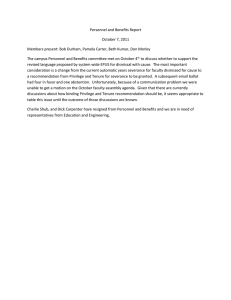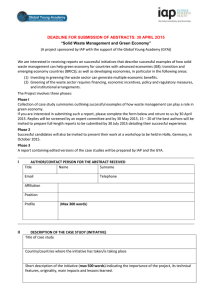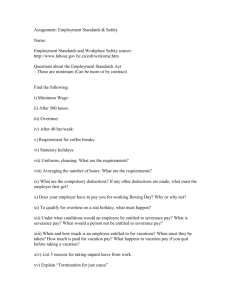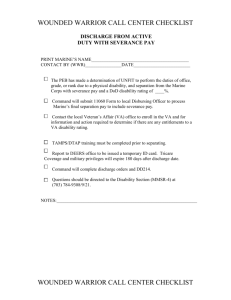Document 13208199
advertisement
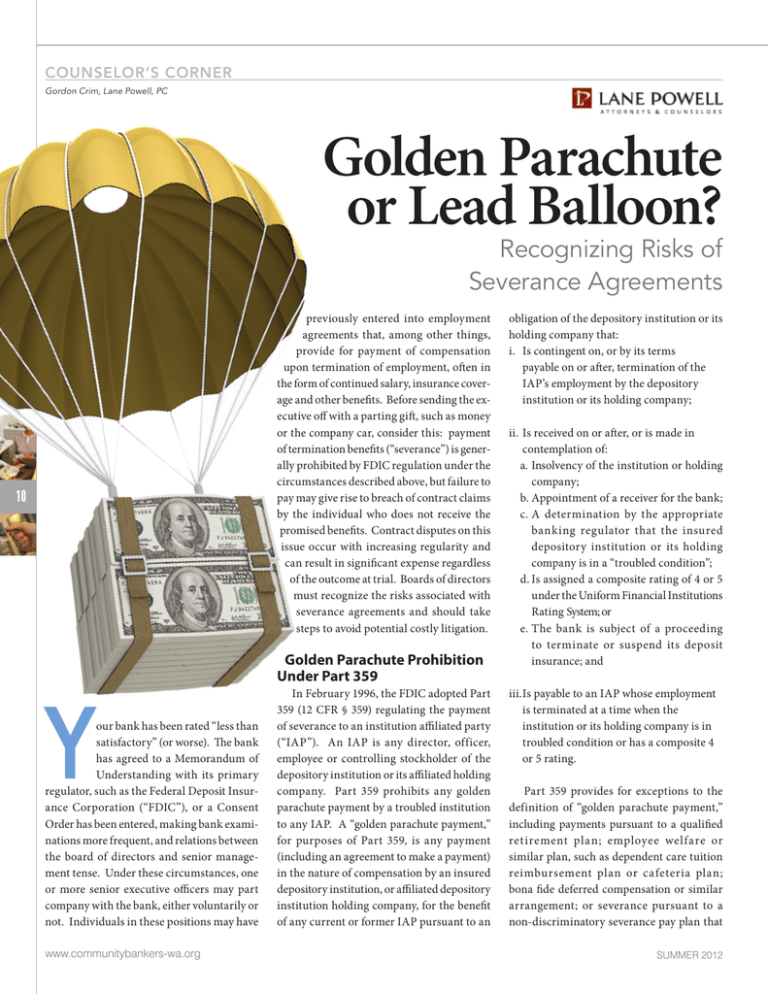
COUNSELOR’S CORNER Gordon Crim, Lane Powell, PC Golden Parachute or Lead Balloon? Recognizing Risks of Severance Agreements previously entered into employment agreements that, among other things, provide for payment of compensation upon termination of employment, often in the form of continued salary, insurance coverage and other benefits. Before sending the executive off with a parting gift, such as money or the company car, consider this: payment of termination benefits (“severance”) is generally prohibited by FDIC regulation under the circumstances described above, but failure to pay may give rise to breach of contract claims by the individual who does not receive the promised benefits. Contract disputes on this issue occur with increasing regularity and can result in significant expense regardless of the outcome at trial. Boards of directors must recognize the risks associated with severance agreements and should take steps to avoid potential costly litigation. 10 Y our bank has been rated “less than satisfactory” (or worse). The bank has agreed to a Memorandum of Understanding with its primary regulator, such as the Federal Deposit Insurance Corporation (“FDIC”), or a Consent Order has been entered, making bank examinations more frequent, and relations between the board of directors and senior management tense. Under these circumstances, one or more senior executive officers may part company with the bank, either voluntarily or not. Individuals in these positions may have www.communitybankers-wa.org Golden Parachute Prohibition Under Part 359 In February 1996, the FDIC adopted Part 359 (12 CFR § 359) regulating the payment of severance to an institution affiliated party (“IAP”). An IAP is any director, officer, employee or controlling stockholder of the depository institution or its affiliated holding company. Part 359 prohibits any golden parachute payment by a troubled institution to any IAP. A “golden parachute payment,” for purposes of Part 359, is any payment (including an agreement to make a payment) in the nature of compensation by an insured depository institution, or affiliated depository institution holding company, for the benefit of any current or former IAP pursuant to an obligation of the depository institution or its holding company that: i. Is contingent on, or by its terms payable on or after, termination of the IAP’s employment by the depository institution or its holding company; ii. Is received on or after, or is made in contemplation of: a.Insolvency of the institution or holding company; b.Appointment of a receiver for the bank; c.A determination by the appropriate banking regulator that the insured depository institution or its holding company is in a “troubled condition”; d.Is assigned a composite rating of 4 or 5 under the Uniform Financial Institutions Rating System; or e.The bank is subject of a proceeding to terminate or suspend its deposit insurance; and iii.Is payable to an IAP whose employment is terminated at a time when the institution or its holding company is in troubled condition or has a composite 4 or 5 rating. Part 359 provides for exceptions to the definition of “golden parachute payment,” including payments pursuant to a qualified retirement plan; employee welfare or similar plan, such as dependent care tuition reimbursement plan or cafeteria plan; bona fide deferred compensation or similar arrangement; or severance pursuant to a non-discriminatory severance pay plan that SUMMER 2012 provides benefits to all eligible employees and limits the benefit to not more than one year’s base compensation. All of the foregoing plans must have been adopted at a time when the bank would satisfy any of the conditions in (ii) above. Part 359 also provides for certain “permissible” golden parachute payments, all of which require the prior consent of the appropriate federal banking regulator. Delaying payment until the bank is no longer troubled or subject to a supervisory directive does not help the departed officer; the prohibition is permanent. The adopting release in 1996 provides that “a golden parachute payment which is prohibited from being paid at the time of an IAP’s termination due to the troubled condition of the insured depository institution or holding company cannot be paid to that IAP at some later point in time once the institution or holding company is no longer troubled.” Contractual Obligation to Pay Severance Many employment agreements between a bank and its IAPs provide for severance (including change in control payments) but do not contemplate the potential applicability of Part 359. Therein lies the risk that the IAP may, subsequent to termination of employment, file a breach of contract claim seeking payment of the very same benefits that the bank is prohibited from paying under Part 359. Settlement is not an option; FDIC views settlement of such claims also as an illegal severance payment. The regulatory prohibition on making a promised payment that was legal at the time the contract was entered into does not necessarily relieve the bank from performance of the contract. Illegality of performance will excuse the contractual obligation on the grounds of impossibility if the illegality is supervening, which means the law changed in the interim between contract and performance. The legal rationale is that the parties to the contract could not have anticipated the possibility of legal performance being subsequently rendered illegal by the time the performance was required. Part 359 has been in force since 1996. Employment contracts with IAPs entered into after that date therefore should anticipate the possibility, however remote, that Part 359 might apply at some time during the contract period if the condition of the bank declined. Failure to anticipate the potential applicability of the restriction therefore would not excuse the contractual obligations, particularly where such obligations are not expressly conditioned on the absence of the restrictions. Indeed, case law on the impossibility doctrine is weighted against the bank for failure to expressly include an appropriate condition in the contract. As an indication of FDIC’s acknowledgment of this conflict between regulatory requirements and state law, FDIC has required inclusion in corporate documents specific provisions to invoke relevant sections of the Federal Deposit Insurance Act. The bank may argue that, because banking is a regulated industry, all activities and contracts of a bank implicitly incorporate an acknowledgment by the parties that all agreements are subject to and superseded by applicable statutes and regulations. Case law, however, does not support the argument that FDIC regulations preempt state contract law. A court might, however, find for the bank on public policy grounds, viewing the regulatory scheme as sufficiently important for the protection of banks to take precedence over individual contract rights. Thus, the departing executive may win the argument but be unable to collect. This is an expensive but avoidable battle to win. Boards of directors must be aware of the risks associated with severance agreements and the possibility that the bank will be unable to perform and consequently be subject to claims of breach of contract. Even if a favorable outcome is expected, litigation to defend against such claims can be prohibitively expensive for a troubled institution. While anyone can file a lawsuit, good drafting can discourage claims of this nature. To avoid these disputes, all new severance agreements with IAPs should expressly include the absence of applicability of Part 359 as a condition of performance by the bank. Existing employment agreements also should be reviewed and amended to include such conditions of performance. Gord on E. Crim is a sharehold er at L ane Powell, w here his practice focuses on counseling boards of directors of business corporations and financial institutions. He can be reached at 503.778.2143 or crimg@lanepowell.com. 11
